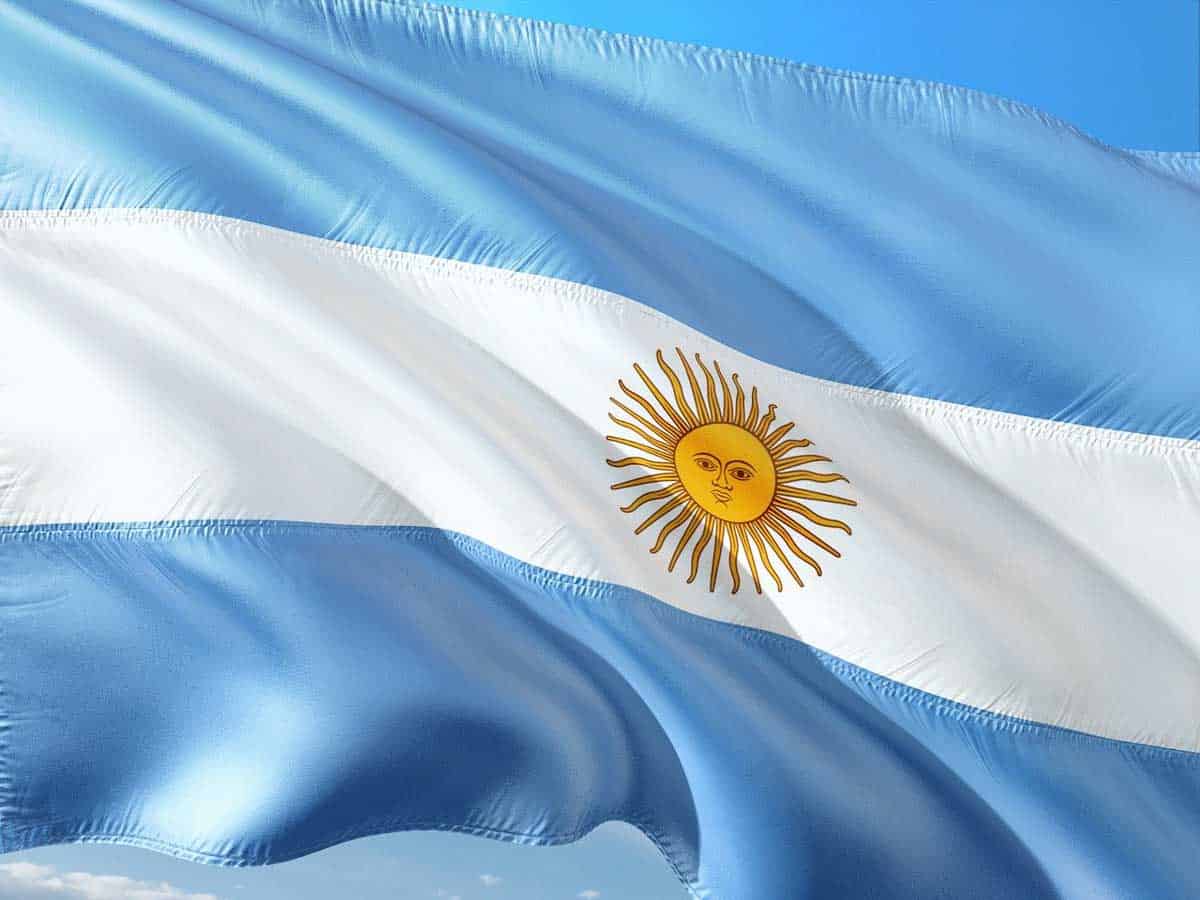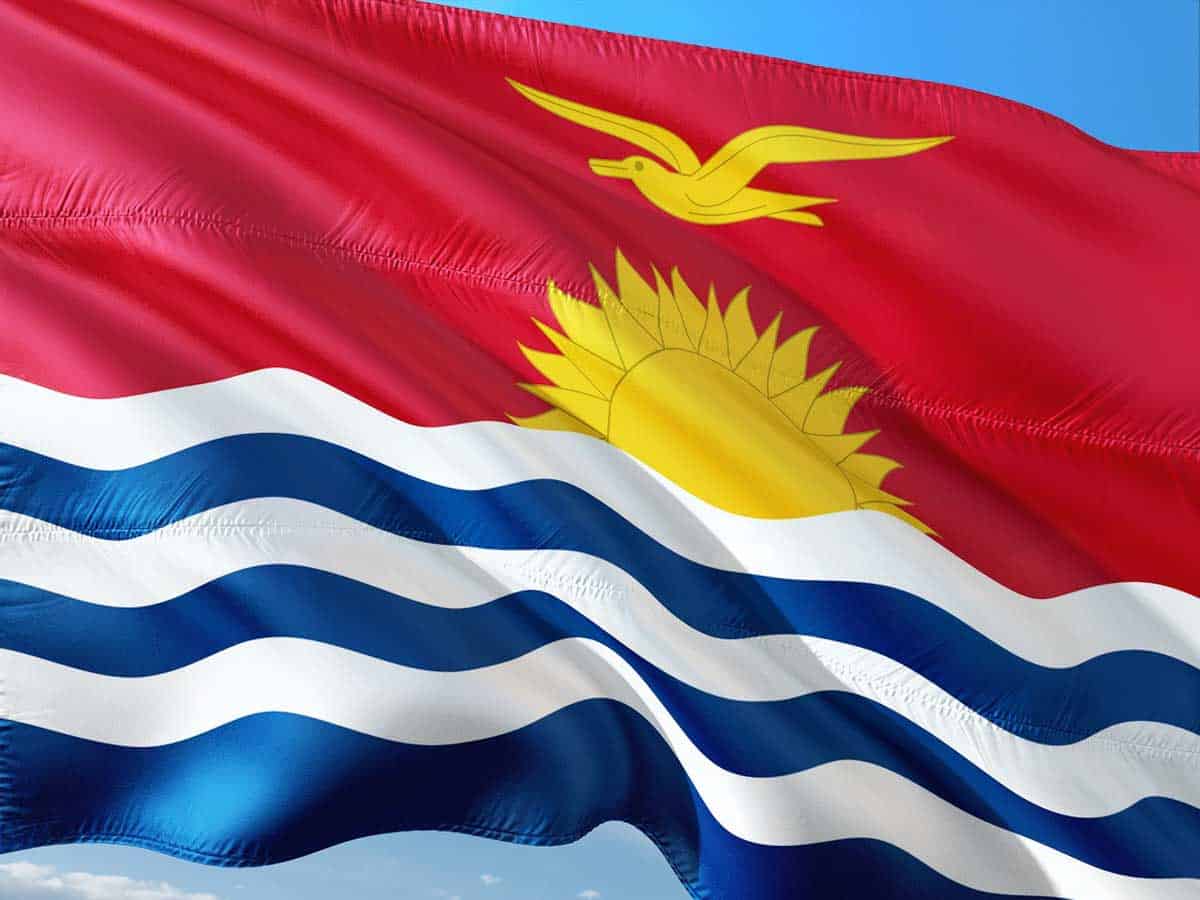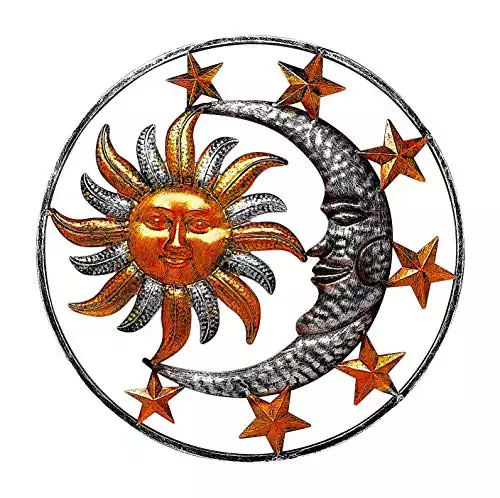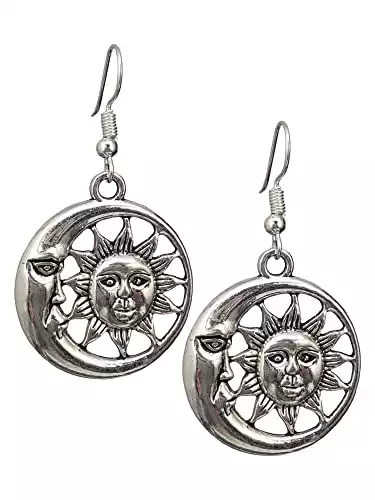In this Article
Toggle
While many national flags feature stars and stripes, only a handful of the world’s 195 countries incorporate a sun into the design. While there are different symbolic meanings of the sun, the most common include life, strength, and power. And when depicted as a perfect circle, the sun is connected to the never-ending cycle of life. Here are some of the most interesting sun flags from around the world.
Gazing into the night sky anywhere in the world, it’s easy to be mesmerized by the many beautiful stars twinkling above. But life on earth would not exist without the most important star in the heavens, the sun. So while roughly 60 countries have hundreds of stars sewn onto their flags, only a few nations have sun flags.
Incorporated into a country’s official flag, the sun may be either yellow or red. It can be drawn as a simple perfect circle, or rays of sunlight might burst from it like a crown. These are the most notable flags with a sun from around the world.

To help offset the costs of running EverydayWanderer.com, you’ll find affiliate links lightly sprinkled throughout the site. If you choose to make a purchase via one of these links, there’s no additional cost to you, but I’ll earn a teeny tiny commission. You can read all of the legal blah blah blah (as my little niece says) on the full disclosure page.

Antigua and Barbuda – A Rising Sun In a “V” for Victory
One of the most prominent features of the Antigua and Barbuda flag is a v-shape that cuts into a red banner. The red hue represents the energy of the people, and the “v” shape celebrates the nation’s independence gained in 1981.
Filling the center of the “v” are ribbons of white, blue, and black with a yellow sun rising on the horizon. The color white represents the sandy beaches of this Caribbean island nation while blue signifies hope and black its African ancestry.
What Does the Rising Sun on the Flag of Antigua and Barbuda Represent?
Rising inside the “v” of victory, the sun on this flag represents the dawning of a new day after 350 years of slavery, colonization, and British rule.

Argentina – Light Blue and White Triband Flag with a Sun in the Middle
Stretching along the Atlantic Coast of the southern tip of South America, Argentina has a flag with a sun. The specific hue of light blue in the flag was selected in 1812 by Manuel Belgrano, an Argentinian economist, attorney, and politician who led the nation’s fight for independence from Spain. However, there is some debate over what the stripes symbolize.
Some say that the light blue and white stripes represent the sky and clouds above Argentina. Others say the blue stripes stand for not just the brilliant blue sky but also the waters of Argentina’s Rio de la Plata or the shade of blue used in the Spanish House of Bourbon in its coat of arms. In addition to possibly representing the clouds, the white stripe may symbolize the country’s silver mines. In fact, the country was named after the Latin word for silver, argentinum, by Spanish conquistadors.
In 1818, a sun symbol with a face known as the Sun of May (el Sol de Mayo) was added to the center of the flag of Argentina. It is a national symbol in both Argentina and Uruguay, Argentina’s neighbor to the east.
What Does the Sun on the Argentina Flag Mean?
The Argentina sun symbol refers to the May revolution in Argentina that ultimately led to the country’s independence from Spain. When Argentinians seeking their independence from Spain gathered in Buenos Aires on May 25, 1810, the sun came out from behind the clouds. So the sun on the Argentina flag represents a hopeful and encouraging sign from above.

Bangladesh – Green Flag with a Red Sun
Nestled between India and Myanmar (Burma), Bangladesh is a country in Southeast Asia about the size of New York state. Despite being relatively small in size, Bangladesh is home to 163 million people, making it the 12th most densely populated country in the world.
Fun Fact: The red sun symbol in the center of the Bangladesh flag is offset slightly in the direction of the flag pole so that it appears to be centered when the flag is flying.
What Does the Red Sun on the Bangladesh Flag Mean?
It’s most commonly believed that the red circle near the center of the Bangladesh flag indicates the sun rising over Bangladesh. The sun is red (rather than a shade of yellow) to symbolize the blood of those who perished fighting for Bangladesh’s independence from Pakistan in 1971.
However, some Bangladeshis say that the red circle in the center of the Bangladesh flag symbolizes the sun setting over the legendary Battle of Karbala. The battle took place from sunrise to sunset in 680, back in the first millennium, and resulted in the death of Husayn ibn Ali and his family. He was the grandson of the Islamic prophet Muhammad, and an important figure in Islam, the religion practiced by approximately 90% of Bangladeshis.
Enjoying This Article?
Sign up for the newsletter!
Thank You for Subscribing!

Ecuador – A Sun Set in a Coat of Arms on a Background of Yellow, Blue, and Red Stripes
Ecuador is located on the west coast of South America, directly south of the narrow isthmus of Panama that connects North and South America. Its flag features a brightly striped background of canary yellow, royal blue, and cardinal red. A sun was incorporated into the Ecuadorian flag when a coat of arms was added in 1900. And, unlike the simplicity of the other sun flags detailed up to now in this article, there is a lot going on in the coat of arms in the center of the Ecuadorian flag.

What Does the Sun on the Ecuadorian Flag Mean?
At the center of the Ecuadorian flag, a sun shines brightly in the middle of a banner that stretches across the egg-shaped portion of the coat of arms carried in the talons of a condor. Rounding out the symbols incorporated into the banner are the zodiac symbols for Aries, Taurus, Gemini, and Cancer.
Situated high above Chimborazo Mountain, the zodiac signs and sun represent the months of March, April, May, and June, which are important to Ecuadorians. These months include national holidays like Carnival, Easter, May Day, the Battle of Pichincha (an important conflict in Ecuador’s fight for independence from Spain), and the summer solstice.
Fun Fact: The flag of Ecuador looks a lot like the flag of Colombia, but the Ecuadorian flag includes a coat of arms.

Japan – A Red Sun at the Center of a White Flag
A nation of more than 6,800 islands on the eastern edge of Asia, Japan is known as the “Land of the Rising Sun.” In fact, the Japanese word for Japan is Nihon or Nippon which literally means “the origin of the sun.”
It is believed that Japan’s name dates back to the seventh century when Prince Shotoku, the regent of Japan, sent a letter to China referring to himself as “the emperor of the land where the sun rises.” Considering the nation’s location on the far eastern edge of the Asian continent, this description makes perfect sense!
What Does the Red Sun on the Japan Flag Symbolize?
In Japan, the national flag is known as Nisshoki (rising sun flag) or Hinomaru (the sun disk). The perfect crimson circle in the center of a white banner is believed to be a nod to Amaterasu Omikami, the sun goddess and most important deity of the Shinto religion. She is considered the mythical founder of Japan and the ancestor of the nation’s emperors. The flag’s white background represents the honesty and integrity of the Japanese people.

A Second Japanese Flag with a Rising Sun
But there is also another rising sun flag associated with Japan. Known as “Kyokujitsuki,” with 16 rays extending from a red disc, this flag has represented the Japan Maritime Self-Defense Force since 1954.
But this rising sun flag has been compared to the Nazi swastika. Why? Because in some Asian countries, especially South Korea, the flag is a reminder of wartime atrocity, causing some to push for a ban on the rising sun flag.

Kazakhstan – A Turquoise Blue Flag with a Yellow Sun
Situated in roughly the center of the earth’s biggest continent, Kazakhstan is a relatively new country in Asia. The former Soviet republic became an independent country in December 1991. When the current flag was designed by Shaken Niyazbekov, he retained the color of the turquoise blue stripe and the hue of the golden yellow hammer and sickle from the old Kazakh Soviet Socialist Republic flag. But as the blue and yellow were fashioned into new symbols, the red banner from the USSR flag was eliminated.
What Does the Golden Yellow Sun on the Kazakhstan Flag Symbolize?
With 32 grain-shaped rays emanating from a golden circle, the sun on the Kazakhstan flag symbolizes life and energy. It also connotes prosperity since wheat is the nation’s most important commodity. The sun is joined by a golden eagle soaring just below the symbol and a vertical koshkar-muiz (the horns of the ram) that parallels the flagpole when the flag is flown over Kazakhstan.

Kiribati – A Partial Sun with 17 Rays Over Ocean Waves
About 3,000 miles southwest of Hawaii, Kiribati is an island nation in the middle of the Pacific Ocean. The nation’s 32 atolls make up just 310 square miles of land (about one-fifth the size of the smallest US state of Rhode Island). But the land is spread over 1.3 million square miles in the spacious Pacific Ocean.
Once known as the Gilbert Islands, after Captain Thomas Gilbert, an Englishman who “discovered” the islands in 1788, Kiribati was granted its independence from the United Kingdom in July 1979. And with significantly more water than land, it’s no surprise that rolling navy blue and white lines representing the ocean comprise half of the Kiribati flag.
What Does the Sun on the Kiribati Flag Symbolize?
A partial sun is rising (or perhaps setting) beyond a white-capped ocean wave. One of the more elegant looking sun symbols on this list of sun flags, the Kiribati sun incorporates 17 overlapping rays, which represent the islands that make up their Pacific Ocean nation.

Kurdistan - Three Bands Secured by a Golden Sun
What Does the Sun on the Kurdish Flag Symbolize?
The bright yellow sun at the center of the Kurdish flag represents the source of life and the light of the Kurdish people. The sun with 21 pointed rays on this flag is known as Roj in Kurdish. It is an ancient sun symbol that has been used by the Kurds for many centuries.
Namibia – African Flag with a Sun in the Corner
Located on the west coast of Africa’s southern tip, Namibia is home to 2.6 million people. The country adopted its current flag the month before officially gaining its independence from South Africa. So the diagonally-striped banner with a sun symbol in the corner was already designed and ready to fly high above the new nation on its independence day on March 21, 1990.
Unlike the other sun flags which incorporate horizontal bands or wavy stripes into their designs, Namibia’s flag stripes are diagonal. A red stripe bisects the banner from the lower left to the upper right corner. While red is often the color of bloodshed, it’s believed that the red stripe in the Namibia flag represents the heroism of the country’s people and their desire to build a future with equal opportunities for all residents.
The thick red stripe is flanked by narrow white stripes similar to the ones in the South African flag. They symbolize peace and unity. The lower right corner of the flag is a leafy green color meant to symbolize agriculture, although the nation has been plagued with farming issues the past few years due to drought, floods, and insects. And the sky blue color in the upper left corner of the flag recognizes both the heavens above and the Atlantic Ocean.
What Does the Sun in the Corner of the Namibia Flag Symbolize?
A canary yellow sun shines on the blue section in the Namibia flag. It is surrounded by 12 pointed triangles that denote rays of sunshine. As is often the case with sun symbols, this sun icon represents life and energy.

North Macedonia - Bright Yellow Rays on a Brilliant Red Background
Located in Southern Europe, Macedonia is one of the oldest and newest countries in Europe. History shows that Ancient Macedonia was a flourishing kingdom that dates back to 3500 BC. In fact, Macedonia is the oldest surviving name of a European country. At the same time, Macedonia is a relatively new country that gained independence from Yugoslavia in September 1991.
What Does the Sun on the North Macedonia Flag Symbolize?

On a brilliant red background, the sun symbol on the flag of North Macedonia is a modern-looking starburst symbol with sunny rays stretching from a simple circle to the edge of the flag’s fabric. With half the rays of the original Vergina Sun symbol, the eight-rayed sun represents “the new sun of Liberty” mentioned in North Macedonia’s national anthem.

Philippines – Red, White, and Blue Flag with a Sun Symbol
East of Vietnam and north of Indonesia, the Philippines is another island nation with a sun flag. And like Japan, the Land of the Rising Sun, the Philippines is an archipelagic country with thousands of islands that are organized into three regions: Luzon, Visayas, and Mindanao.
Although using the most popular shades of red, white, and blue, the Philippine flag positions them in a unique manner. The blue and red stripes bisect the banner horizontally while a white triangle pushes into them from the hoist line.
What Does the Sun on the Flag of the Philippines Symbolize?
Just to the right of the center of the white triangle on the Philippines flag is a sun symbol representing unity, freedom, and democracy. The yellow sun circle is surrounded by eight rays, one for each province that played a significant role in the nation’s fight for independence from Spain in the late 1800s.
Each ray is made of three pointed lines, and the sun symbol is accented with three five-pointed yellow stars. The number three in both cases is believed to represent the three main regions of the island nation.

Rwanda – A Triband Flag with a Sun in the Corner
Landlocked in central Africa, Rwanda is located just south of the equator. And, at just over 10,000 square miles in size (a bit smaller than the state of Massachusetts), Rwanda is one of the smallest nations on the African continent.
After colonization first by the Germans and then the Belgians, Rwanda gained its independence from Belgium on July 1, 1962. The first Rwanda flag was a vertical tricolor in the bright shades of red, yellow, and green commonly used throughout the African continent. The yellow stripe in the middle included a black letter “R” to separate it from the otherwise similar flag of Guinea.

The Rwanda flag was redesigned in 2001 in part to distance the country from the genocide that took place against the Tutsi in 1994. Although the current Rwanda flag was adopted a full decade after Kazakhstan’s sun flag, the flag of Rwanda features a similarly bright blue and gold color.
At the bottom of the Rwanda flag is an emerald green horizontal stripe designed to represent prosperity. The middle band is golden yellow, symbolizing economic development. And the aqua-colored blue band that comprises the top half of the flag signifies happiness and peace.
While Rwanda has had its challenges, roughly 85 percent of its citizens can read and write, and at least one million residents (about eight percent of the population) have moved above the poverty line in the past decade. Hopefully the country will continue to see the symbolic green and gold from their new flag materialize.
What Does the Sun on the Rwanda Flag Represent?
Positioned in the upper right hand corner of the flag, opposite the hoist line, the beautiful sun symbol on the Rwanda flag is said to represent enlightenment.

Seychelles – A Colorful Sunburst of Oblique Triangles
In the Indian Ocean, off the east coast of Africa, Seychelles is a sovereign nation of 115 islands that received its independence from the United Kingdom in 1976. In addition to fishing, farming, and manufacturing, tourism is an increasingly important industry. After all, who wouldn’t want to spend a week (or maybe a month) lounging on one of the white sand beaches or snorkeling in one of the coral reefs?
Fun Fact: With under 95,000 people, Seychelles’s population is the smallest of any African nation.
With five colorful stripes radiating from the bottom left corner like a sunburst, each ray of color in the Seychelles flag has meaning. The royal blue triangle that hugs the hoist line represents the sea that surrounds the Seychelles islands as well as the sky overhead.
Moving clockwise through the oblique bands of color, the yellow stripe in the sunburst represents the sun. The cherry red stripe in the middle signifies a desire for the people of Seychelles to work together in unity and love while the white band to its right represents peace and harmony. And on the far right, the green triangle represents the land and the country’s agriculture.

Taiwan – Red and Blue Flag with a Sun in the Corner
Officially known as the Republic of China (ROC), and not to be confused with the People’s Republic of China (PRC), Taiwan (ROC) is an island in southeast Asia off the coast of mainland China (PRC). Slightly larger than the state of Maryland, Taiwan is home to 23.7 million people, giving it a high population density similar to Bangladesh.
As you’ve likely seen in the news, Taiwan’s status as a sovereign nation is a bit complicated. Mainland China sees the island as a renegade territory and wants to bring it back into the fold. Meanwhile, many Taiwan residents want a separate nation.
The current flag flying over Taiwan was officially adopted in October 1928. It features red, white, and blue shades similar to America’s Stars and Stripes. The predominantly crimson background represents not only the ultimate sacrifice of the people who overthrew the Qing Dynasty in 1911 to create Taiwan but also livelihood and fraternity.
The blue rectangle in the corner represents nationalism and liberty. And the white sun shining from the center of a royal blue rectangle symbolizes democracy and equality.
Sage Advice: Do you plan to visit Taiwain? These are the best things to do in Taipei.
What Does the Sun on the Flag of Taiwan Stand For?
This red flag with a blue corner and white sun is the only sun flag with a white, rather than yellow or red, sun. Twelve triangle sunbursts encircle the white center of the sun. They represent time in two distinct ways. The first reference is to the 12 months of the calendar year. The second is to the twelve traditional shichen — a unit of time that breaks a 24-hour day into 12 two-hour increments.

Uruguay – A Sun Flag Featuring the Sun of May
Just east of Argentina, Uruguay sits along South America’s Atlantic Coast between Argentina and Brazil. While Argentina won its independence from Spain, and Brazil from Portugal, Uruguay won its freedom in a four-way power struggle, first from the European nations of Spain and Portugal, but then from its neighbors, Argentina and Brazil.
What Does the Sun Represent on the Uruguay Flag?
The sun flag flying over this South American nation was adopted by Uruguay in 1830. It features nine white and lapis blue stripes, which represent the nine departments of Uruguay. And in the upper left corner, in the center of a white rectangle, shines a slightly different version of the Sun of May that rests in the middle of the white stripe on the Argentina flag.
Frequently Asked Questions About Flags with Suns
How many countries have a flag that features a sun?
There are nearly 20 countries with flags that feature a sun. Some of the countries featured in this article include:
- Antigua and Barbuda, with a sun rising above a “V” for victory
- Argentina, with the Sun of May on a white stripe
- Bangladesh, with a red sun on a green flag
- Ecuador, where the sun is incorporated into a coat of arms
- Japan, with a red sun on a white flag
- Kazakhstan, where the yellow sun is incorporated into a turquoise flag
- Kiribati, with a sun rising over gently rolling ocean waves
- North Macedonia, where a Vergina Sun was replaced by a more modern starburst
- Namibia, with a sun in the corner of a blue triangle
- Philippines, where a sun and three stars is incorporated into a white triangle
- Rwanda, with a sun in the corner of its striped flag
- Seychelles, with a bright and colorful sunburst design
- Taiwan, with a silvery sun set on a blue rectangle in the corner
- Uruguay, with the Sun of May set in the corner of a blue and white striped flag
What does a sun mean on a flag?
While a sun on a flag may represent different things in different countries and cultures, they typically symbolize things like light, life, and energy. Suns on flags can also mean hope and the dawning of a new day.
What's the name of the sun on the Argentinian and Uruguayan flags?
Known as the Sun of May, the sun incorporated into the flags of Argentina and Uruguay has a face in its center and is associated with the May revolution that led to independence from Spain.
Which European country has a sun on its flag?
North Macedonia. And on a continent where flags with stripes, stars, crosses, and crests are prevalent, this sun flag featuring a bright yellow starburst on an eye-catching red background really stands out!
What flag is blue and white with a sun?
Both Argentina and Uruguay have flags that are blue and white with a sun. The Argentinian flag has two light blue and one white stripe with a Sun of May sun symbol in the center. The flag of Uruguay features nine white and lapis blue stripes with a Sun of May sun symbol in the upper left corner.
What flag is red with a yellow sun?
The flag of North Macedonia is red with a bright yellow sun. The sun symbol on the North Macedonian flag starts as a simple circle with rays stretching to its corners.
Which Sun Flags from Around the World Do You Like Best?
What color sun or sun icon appeals most to you? Do you find the history of one of these sun flags particularly fascinating? Have I missed any country that features a sun on its flag? Share your thoughts in the comments section below.
Ready to Go?
Use These Helpful Links to Book Your Trip!
- Find low fares with airfarewatchdog and Skyscanner
- Book your plane ticket with Expedia or Kayak
- Or take the scenic route on an epic road trip in a rental car or an RV from Outdoorsy
- From hotels to private homes, find the perfect accommodation with Hotels.com or Vrbo
- Travel in style with a suitcase, carry-on, backpack, or handbag from eBags
- Save on tickets to attractions, sightseeing tours, and more with CityPASS, Tiqets, and Viator
- Don’t leave home without travel insurance from AXA
- Discover the sights, history, and culture of your destination with an interactive scavenger hunt
- Need something else to plan your perfect trip? Visit my travel resources page for more trusted partners. Happy wandering!
Thank you for sharing!








































No Macedonian flag (entirely made of the sun)?
It’s there now! Let me know if I’ve done it justice!
Kurdistan’s flag has a sun.
It’s added to the article now. I hope I’ve done it justice!
You’ve shown the Philippine flag with its red band uppermost which occurs when the country is officially at war because the red symbolizes patriotism and valor (but the country isn’t at war). Most of the time it should be flown with the blue field uppermost for peace, truth, and justice. The white equilateral triangle represents liberty, equality, fraternity, and the three golden yellow stars represent the three major island groups (Luzon, Visayas, Mindanao). The golden yellow sun represents unity, freedom, people’s democracy, and sovereignty. The sun’s eight rays stand for the eight provinces that first declared independence from Spain.
Thanks for sharing this beautiful symbolism! (And, I’ve updated the photo of the Philippine flag to be sure to show the blue band on top, because the world needs more peace and less war!)
Wow! This is really interesting! We had no idea about the meaning of the sun in most flags, except for the one on the Japanese flag! Thanks a lot for this thorough research and for sharing it with us!
wow you clearly spent a great deal of time researching for this post! Had no idea that the sun was featured so prominently all around the world. Interesting how they all have different numbers of rays too!
Fascinating blog post, I read a book about Karibati – some memories and your post reminded me on it.
That sounds pretty interesting! What was the book?
This is such a fun idea to write about! I love that you took the time to research all of these – it is so interesting to read. I’m not sure I’ve seen the Rwandan flag before, but I find it really lovely! Thanks for compiling these.
The new Rwanda flag is way cooler than the old one, that’s for sure!
This is a lovely idea for a post! I had never really thought about it, but I guess you are right that the sun is really not featured on most national flags. I think I remember reading somewhere that purple is also very rare on flags, for whatever reason? In any case, I learned a lot by reading your post: for example, I even have an Ecuador flag hung up in my apartment and never realized that the coat of arms has a sun on it! It must’ve been time consuming to gather all the information for this post, but you present it clearly in an interesting way. Kudos!
Oh, I’m so glad you enjoyed it! I never thought about the color purple on national flags until you mentioned it, but you’re right. Beyond the rainbow flag for gay pride (granted, that’s not a national flag), I cannot think of any flags featuring purple. Since purple has long been tied to monarchies, this is even more surprising! Per a quick Google search, it looks like only the Dominican and Nicaraguan flags include purple. And in both cases, it’s not much. For Dominica, it’s part of the parrot in the center of the flag. And for Nicaragua, it’s part of the rainbow in the triangle. So interesting! Thanks for sharing your thoughts!
What an interesting idea for a blog post! As I began reading, I tried to recall the flags with suns on them. Japan immediately popped into my head followed by Uruguay. I didn’t realize there were so many others or all the many meanings behind the symbol!
It’s ironic, right? The most important star to live on earth is the sun, yet it is shadowed by generic stars on national flags.
Yeah, I hadn’t thought of it that way before!
What a fascinating read! I had never considered the meaning behind suns on flags. I was particularly interested in Japan, I had wondered why it was red. It does make complete sense to call themselves the land of the rising sun!
I’m glad you enjoyed it! I still can’t get over how less frequently suns are featured on national flags compared to stars (and stripes).
Super interesting article! While visiting South America I heard so much about the Argentine and Uruguayan flags. Mainly that the Uruguayans were complaining about the similarity of their flags, but said at least their sun is smiling 😀
Oh, that’s funny!
I always find flags really interesting and the symbolism behind them and you’re right, there aren’t that many really with suns. Which is strange in a way seeing as how much we need the sun to live and how powerful an image it can create.
I’m glad I’m not the only person who enjoys the meaning behind flags!